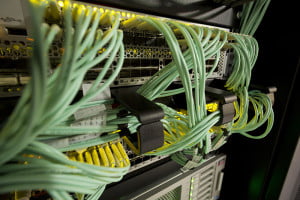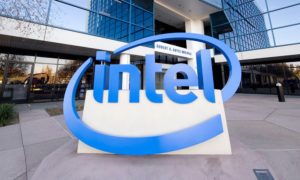Case 1: Amazon
The working relationship between Amazon Web Services (AWS) and ICRAR began in 2012, through the SkyNet project. AWS provided an education grant to help financially support a collaborative relationship for astronomy R&D of data handling infrastructure.
The collaboration spanned over a year and through development of the relationship, ICRAR secured Amazon’s collaborative assistance in the SDP SKA pre-construction design package. Amazon is aiding ICRARs efforts in the design of the SKA Data Layer Work Package (within SDP).
The scope of works includes data storage, database architectures, the integration of cloud computing into scientific workflow among other tasks. AWS advanced expertise in cloud computing, data processing and delivery provide valuable input for the ICT team at ICRAR UWA.
Case 2: Balance Utility Solutions
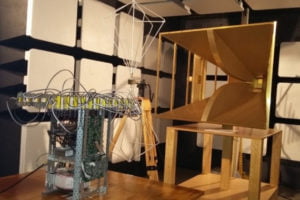
The AAVS1 array power distribution control unit unboxed and undergoing electromagnetic compatibility testing. Credit: Curtin University/ICRAR
Balance Utility Solutions is a West Australian company, providing sustainable energy supply and storage solutions for clients, with a particular focus on solar.
As lead Australian partner of the LFAA consortium, ICRAR has contracted Balance Utility Solutions to conduct feasibility studies and collaboratively develop prototypes of radio-quiet power solutions for phase one of LFAA.
Case 3: GCo
GCo Electrical was selected by ICRAR-Curtin University as the lead contractor for the Murchison Widefield Array (MWA) telescope infrastructure, and has had a presence on the SKA site ever since.
The company has been involved in maintenance, upgrades and related infrastructure for the MWA and fellow precursor telescope the Australian SKA Pathfinder (ASKAP). Most recently, GCo worked with ICRAR/Curtin University on SKA preconstruction plans, developing and costing a blueprint to deploy more than 130,000 antennas for the low-frequency part of the SKA.
Download PDF
Case 4: Intel
Intel Corporation is an American multinational leading the world in designing and manufacturing technologies for computing devices.
ICRAR’s collaborative effort with Intel has resulted in early access to pre-release advanced computing technologies, software engineering resources and HPC platforms.
This accessibility has provided ICRAR with strong foundations to support their leadership role in the SKA data layer work package in the SDP pre-construction package.
Case 5: DUG Technology
WA technology company DownUnder GeoSolutions teamed up with ICRAR to search for signals from the first stars and galaxies.
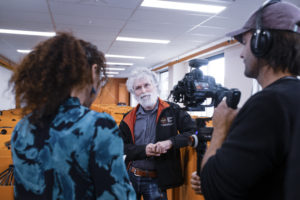
ICRAR’s Director of Data Intensive Astronomy. Professor Andreas Wicenec, being interviewed on location at DUG Technology.
The company worked with ICRAR and the Pawsey Supercomputing Centre to process observations of the early Universe from the Murchison Widefield Array (MWA) telescope in outback Western Australia. The project involved an enormous 200 terabytes of data—roughly equivalent to downloading all 73 episodes of Game of Thrones 1800 times.
The telescope observations were transferred to DUG Technology’s supercomputer in West Perth, where their software engineering team optimised the processing algorithms and delivered the processed data in record time.
DUG has deep roots in software development and big data processing in the exploration of oil and gas. From its humble beginnings in a shed in Subiaco, the company now owns and operates some of the largest compute systems in the world.
Case 6: Summit
ICRAR’s big data scientists tested data processing algorithms they developed for the Square Kilometre Array (SKA) on the world’s most powerful supercomputer.
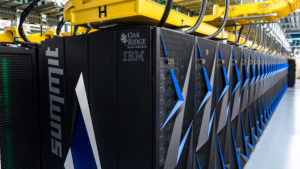
Summit — Oak Ridge National Laboratory’s 200 petaflop supercomputer. Credit: Oak Ridge National Laboratory.
Known as Summit and based at the US Department of Energy’s Oak Ridge National Laboratory, the supercomputer has a peak performance of 200,000 trillion calculations per second.
In 2019, ICRAR researchers used Summit to process simulated observations of the early Universe ahead of the radio telescope being built in Western Australia and South Africa. They were able to process 400 gigabytes of data a second—the equivalent of more than 1600 hours of standard definition YouTube videos.
The test used a sophisticated piece of software written by ICRAR, called the Data Activated Liu (Flow) Graph Engine (DALiuGE). It was the first time radio astronomy data had been processed on this scale.
Case 7: Think Bottom Up
Enabling local tech entrepreneurs is a core part of ICRAR’s work. The centre helped WA start-up Think Bottom Up to prepare their unique and innovative database engine for the world stage.
ICRAR embedded Think Bottom Up’s distributed database technology into prototype execution framework DALiuGE to perform data life cycle management. The DALiuGE framework was developed at ICRAR for the largest radio telescope in the world, the Square Kilometre Array (SKA), and is capable of managing unprecedented amounts of data.
For Think Bottom Up, the data pipelines for the SKA represented an extreme example of high performance and massively distributed computing—and an ideal test case for the company’s technology. Being associated with an important and highly-visible international also helped to boost Think Bottom Up’s profile in Western Australia and around the world.
